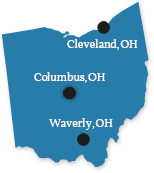For most injured Ohio workers, workers’ compensation is the first–and perhaps only–source of compensation. That’s because in Ohio, workers’ compensation is an exclusive remedy. That means an employee injured on the job typically can’t sue their employer, even if the employer’s negligence contributed to the injury.

The upside to this system is that with few exceptions, workers’ compensation benefits are available for anyone who was injured in the course of employment. There’s no need to prove that the employer did anything wrong. In fact, an injured employee can usually receive workers’ compensation benefits even if the injury was their own fault. And some workers’ compensation benefits become available very quickly. But there’s a downside, too. Workers’ compensation benefits are more limited than the damages an injury victim may be able to recover in a personal injury lawsuit.
Ohio Workers’ Compensation Benefits
Core Ohio workers’ compensation benefits include:
Medical Benefits
Medical benefits cover all reasonable and necessary medical care required as a result of the workplace injury or illness. This includes:
- Consultations with general practitioners or specialists related to the injury;
- Coverage for hospital stays, surgeries, and emergency treatments;
- The cost of drugs prescribed to treat or manage the workplace injury;
- Physical therapy, occupational therapy, and other rehabilitation treatments needed to restore functionality.
It’s important to note that treatment must be authorized by the Bureau of Workers’ Compensation (BWC) or the employer’s Managed Care Organization (MCO) if the employer is self-insured. All care must be directly related to the injury or condition for it to be covered.
Temporary or Permanent Total Disability Benefits
Ohio’s workers’ compensation system provides wage replacement benefits when a worker cannot return to their job due to injury. There are two main types:
- Temporary Total Disability (TTD): These benefits apply when an injured worker is temporarily unable to work. Workers receive 72% of their average weekly wage for the first 12 weeks, then 66.67% thereafter. Payments continue until the worker is able to return to work or reaches maximum medical improvement (MMI), meaning their condition is unlikely to improve further with treatment.
- Permanent Total Disability (PTD): These benefits are for workers who cannot return to any type of work due to a severe permanent injury. This may include catastrophic injuries such as loss of limbs, paralysis, or serious neurological damage. PTD benefits provide ongoing payments that help support the injured worker for the remainder of their life. The amount is based on a percentage of the worker’s earnings prior to the injury.
Working and Non-Working Wage Loss Benefits
Wage loss benefits help compensate workers who are unable to earn their full income due to a workplace injury. These benefits come in two forms:
- Working Wage Loss: If you are able to return to work, but only in a modified role or reduced hours that result in lower earnings than before the injury, working wage loss benefits are designed to compensate for this difference.
- Non-Working Wage Loss: This applies when you are medically cleared to return to work but cannot find a job that accommodates your injury-related limitations.
Vocational Rehabilitation
Vocational rehabilitation services are available to workers who are unable to return to their previous job due to a workplace injury but may still be able to work in another capacity. These services are designed to help injured workers acquire new skills, find suitable employment, or transition into a different career.
Permanent Partial Disability Benefits
Permanent partial disability (PPD) benefits are available when an injured worker has a permanent impairment but is still able to work in some capacity. These benefits compensate workers for the lasting effects of the injury.
There are two types of PPD benefits in Ohio:
- Scheduled Loss: This option applies to injuries involving the loss of a specific body part, such as an arm, leg, finger, or toe.
- Non-Scheduled Loss: This applies to injuries or conditions that result in permanent impairment but don’t involve the loss of a specific body part.
PPD benefits provide compensation for the permanent loss of function and are typically paid out over time or as a lump sum, depending on the situation.
Death Benefits
In the unfortunate event that a workplace injury results in death, Ohio workers’ compensation provides death benefits to the dependents of the deceased worker. These benefits are meant to provide financial support to the family.
There may be other types of workers’ compensation benefits available in specific circumstances, such as when a worker is going through rehabilitation or has been medically advised to change professions. However, a workers’ compensation claim doesn’t allow for any of the intangible damages that are typically experienced in a personal injury case. For instance, an injured worker will not receive compensation for pain and suffering, no matter how painful or drawn-out the recovery is.
Potential Complications with Workers’ Compensation Claims
While the Ohio workers’ compensation system is designed to streamline compensation and avoid conflict between employee and employer, benefits aren’t always as automatic as you might expect. Depending on the injury and specifics of the case, some complications that may arise include:
- The employer arguing that the injury did not occur in the course of employment;
- The employer arguing that the circumstances surrounding the injury fall into one of the exceptions to workers’ compensation coverage, such as injuries caused by horseplay;
- The employer arguing that although the injury occurred at work, the injured worker is not entitled to benefits;
- A dispute about whether the the treatment requested by the injured worker’s physician should be authorized;
- Disagreement about when or to what extent the injured worker is able to return to work.
Do not wait for a claim to be denied, delayed, or experience negative consequences that will impact your benefits in the future. It is best to speak to an experienced workers’ compensation attorney right away to ensure that your claim is established in a manner that allows you to recover all the medical and compensation benefits you are entitled to under the law. As with most situations, it is wise to speak to an attorney before negotiating or accepting a lump sum settlement. While the amount of money offered early in a case may seem significant and a settlement may be tempting to an injury victim whose income has been limited and may be facing further limitations, accepting a settlement can be short-sighted and is often only advantageous to the employer.
Typically, a workers’ compensation settlement will cut off the possibility of any future benefits. This is especially risky as it is often not clear whether or what future medical treatment may be necessary. Settling too soon could leave the injured worker responsible for any future medical expenses. Depending on the injury and treatment required, that could be very costly–in some cases, so costly that the injury victim might not have access to the necessary treatment.
Other Possible Sources of Compensation
An injured worker in Ohio, but for a few specific exceptions, cannot sue their employer for injuries sustained on the job, but there may be other options in some cases. In some situations, there may be a third party who is responsible for the injury, or who shares responsibility. One example might involve a delivery driver who was injured in an automobile accident on the job. If the accident happened due to another driver’s negligence, then the injured worker may have a personal injury claim against that other driver.
There’s generally no double-dipping allowed. For instance, the injured worker couldn’t expect to have workers’ compensation pay for their medical care, then also recover damages from the negligent driver to cover medical expenses. Similarly, the claimant can’t receive replacement income through workers’ compensation and then receive compensation for lost wages to replace the same lost income that’s already been paid.
However, a personal injury suit may lead to compensation above and beyond what’s available through workers’ compensation. For example, workers’ compensation pays temporary total disability benefits at a rate of 66.67% to 72% of the employee’s regular income, while a personal injury claim may result in full replacement of income. More significantly, a personal injury claim opens the door to compensation for intangibles like pain and suffering, loss of enjoyment of life, and benefits for your spouse or immediate family members.
Understanding Injuries Not Covered by Ohio Workers’ Compensation
Ohio’s workers’ compensation system is designed to cover most injuries that occur during the course of employment, but there are some situations that may not be covered. Knowing these exceptions can help you manage your expectations when filing a claim.
- Horseplay Injuries: If an on-the-job injury happens due to rough or inappropriate behavior at work (commonly referred to as horseplay), workers’ compensation benefits may be denied. Since horseplay is not considered part of your job duties, Ohio law typically excludes these injuries from coverage, even if they occur on company property.
- Intoxication: Workers’ compensation claims can also be denied if the injury happened while the worker was under the influence of alcohol or drugs. If an employer can prove that intoxication was a factor in causing the injury, the claim may be rejected.
- Pre-Existing Conditions: Workers’ compensation usually does not cover injuries that result from pre-existing conditions. However, if your work environment or job duties worsen a pre-existing condition, you may still be eligible for benefits. It’s essential to provide medical evidence showing how the workplace aggravated your condition.
Understanding these exclusions will help you avoid common pitfalls when submitting your workers’ compensation claim.
Medical Exams and Their Role in Workers’ Compensation
Medical evaluations play a deciding role in the outcome of a workers’ compensation claim. If you’ve been injured on the job, expect your employer or the Ohio Bureau of Workers’ Compensation to request a medical exam.
- Independent Medical Examinations (IME): In some cases, the BWC or your employer may request that you undergo an independent medical exam. This evaluation is conducted by a doctor who hasn’t treated you before. The goal is to assess the extent of your injury, determine if it is work-related, and evaluate your ability to return to work. While this exam can sometimes feel biased toward the employer, it’s a standard part of the process. When dealing with IMEs, we recommend that you answer only the questions the examiner asks, do not elaborate unless asked, and do not offer more information than what is asked. The examiner is not trying to help you, they are there to help deny your claim or limit your employer’s exposure.. When meeting with your treating physician you should be as forthright and specific to get the best care possible
- Documenting Your Symptoms: It’s important to be as detailed as possible when describing your symptoms and how the injury has impacted your ability to work. The results of these exams play a role in determining whether your benefits are approved and when you may return to work.
Staying informed about these medical evaluations and their impact on your claim will help you prepare for this part of the workers’ compensation process.
Maximizing Your Workers’ Compensation Benefits
To get the most out of your workers’ compensation benefits, it’s important to take certain steps throughout the claim process.
- Document Everything: Keep detailed records of your medical treatments, symptoms, and any communication with your employer or the Ohio BWC. Having a clear timeline and proof of your injury can strengthen your claim and prevent delays.
- Follow Medical Advice: Always follow the treatment plan recommended by your healthcare provider. Failing to do so may lead to a reduction or termination of your benefits. Attend all follow-up appointments and therapies to ensure your condition is well-documented.
- Stay Proactive: Keep in touch with your claims administrator and follow up regularly to ensure that your paperwork is processed correctly and that you aren’t missing any deadlines. This will help avoid unnecessary delays in receiving your benefits.
Taking these steps can help ensure that you receive the full amount of benefits you’re entitled to under Ohio workers’ compensation law.
Talk with an Attorney Who Does it All
Not every workers’ compensation case involves third-party claims. But when those claims are available, they often significantly increase the potential compensation. The best way to increase your chances of receiving the maximum compensation available is to work with an attorney experienced with both workers’ compensation claims and personal injury cases. The workers’ compensation attorneys at Plevin & Gallucci have been fighting for injured workers and personal injury victims for decades. They understand the interplay between these two areas of law and the importance of exploring all possible claims.
They also know how important it is for you to have accurate information as soon as possible after your injury. That’s why they offer free consultations to injured workers and other Ohio injury victims. You can schedule yours right now by calling 855-4PLEVIN or filling out the contact form on this page.

